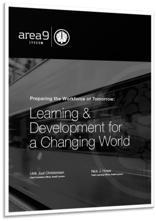To level the playing field of future job opportunities, all workers must be reskilled to meet the ever-increasing demands of the technology-enabled workplace. This requires the “rulebook” for learning to be rewritten, no longer assuming a distribution curve in performance, but rather seeing everyone as capable of achieving proficiency and mastery, provided they are given the targeted support and time they need.
Reskilling workers is an urgent need as new technology rapidly transforms the workplace. While companies in the past have relied on hiring new people who have the knowledge and specialized skills to be productive from day one, a pervasive skills shortage is making it more advantageous and cost effective for organizations to retrain workers. The question then becomes how to prepare the greatest number of people to assume a wider and more demanding array of opportunities?
Training too often has followed a check-the-box approach. This type of thinking undermines learner engagement. Even where learning is considered valuable, especially if it supports a credential, it is expected that outcomes will vary; some will pass, some will fail. This creates a hierarchy of achievement that stifles the development of all workers. Instead, training should be approached with the overarching premise that anyone is able to reach proficiency, given enough time and the right targeted assistance. This premise is crucial as more employers seek to retrain workers and equip them with higher-level skills.
A case in point is Amazon’s $700 million Upskilling 2025 initiative to retrain 100,000 of its employees. The mega-retailer did not provide details of how it intends to roll out retraining across about one-third of its workforce but did state: “We will continue to pilot new upskilling programs and quickly scale them when existing initiatives are successful.”
Most laudable is Amazon’s intention to expand workers’ skill sets to make them eligible for more opportunities in the future. Moreover, it appears that the skills training programs will be widely available for employees in corporate offices, tech hubs, fulfillment centers, retail stores, and transportation networks.
A key takeaway here is that reskilling workers at all levels can create and support greater equality of opportunity. For that to become a reality, though, it’s not enough to merely open the door; people need to have the right support to make it through the door and complete their learning journey.
Why Pass/Fail Is Outdated
To enable widespread reskilling of workers, we need to examine outdated thinking and models. Historically, much of education from first grade through corporate learning and development (L&D) has operated on explicit or implicit assumptions that there is only pass or fail. The view is that some people will do better, and others will do worse; some will succeed, and some will fail. This is also built into higher education with grading to a curve that assumes a distribution of achievement.
In our world of personalized adaptive learning, however, we disavow the concept of pass or fail. Rather, we see people as either proficient or as incomplete in their skill-building and in need of additional development. Adaptive learning embraces the assumption that, with enough time and the right support, virtually anyone can be proficient. Amplifying that point, leading researcher Anders Ericsson has shown that capability and outcome for learners are much more based on nurture rather than nature. This not only dispels the belief that some people are born to achieve more than others (resulting in the bell curve of achievement), it also means that, given the right circumstances, even the “average” person can achieve extraordinary things.
Most current L&D models, however, have not been set up to achieve that potential of universal proficiency because they do not support learners with personalized assistance. The reason is simple: historically, it has been uneconomical to do so. Instead, L&D programs typically use a self-paced online learning approach that allows learners to work at their own speed but fails to provide any help to those who struggle. Having ample time without personalized support cannot meaningfully close the skills gap.
In theory, the instructor in a classroom environment provides that personalized support—not just standing in front of a group of learners and lecturing but helping each individual. From a practical standpoint, however, in any group setting this personalized approach is usually severely compromised because of class size and the sheer volume of content to be taught. The unfortunate truth about the system is that the major objective in the classroom or online has been getting through the content, rather than ensuring every learner achieves proficiency and mastery.
This truth must change to meet the demands of the 21st century workplace. As machines make greater inroads, taking over tasks in most jobs and eliminating some jobs completely, workers must be equipped with higher-level skills, as well as 21st century skills of communication, collaboration, creativity, and critical thinking. Making that vision a widespread reality requires targeted personalized support.
Adaptive Learning Levels the Playing Field
Thanks to the use of technology-enabled personalized instruction, people can achieve substantially more than they can through classroom-based or self-paced, nonadaptive online instruction. Moreover, personalized adaptive learning shifts the cost equation dramatically compared to traditional learning methods. The even bigger benefit, particularly from a talent development perspective, is that personalized adaptive learning is the key that unlocks widespread proficiency and mastery across the workplace.
Traditional learning assumes a fixed time for instruction and a distribution in performance. Adaptive learning, however, takes the opposite view: It assumes fixed performance (outcome) while time is the distribution. In other words, everyone achieves 100 percent proficiency; the only variable is the time it takes.
As we have seen in our adaptive learning programs, the faster learners achieve and demonstrate proficiency twice as fast as learners at the median. Learners who need the most help are twice as slow as those at the median. The result is a distribution in time that shows some people take four times longer than others. But what of it? If the goal truly is proficiency for all workers to be successful in the 21st workplace, then the time it takes doesn’t matter. Learning is an investment for the employer and the employee—not a competition.
Download our latest white paper:
Preparing the Workforce of Tomorrow - Learning & Development for a Changing World










